
Soil classification deals with the systematic categorization of soils based on distinguishing characteristics as well as criteria that dictate choices in use.

Soil classification deals with the systematic categorization of soils based on distinguishing characteristics as well as criteria that dictate choices in use.
Soil classification is a dynamic subject, from the structure of the system, to the definitions of classes, to the application in the field. Soil classification can be approached from the perspective of soil as a material and soil as a resource.
Inscriptions at the temple of Horus at Edfu outline a soil classification used by Tanen to determine what kind of temple to build at which site. [1] Ancient Greek scholars produced a number of classification based on several different qualities of the soil. [2]
Geotechnical engineers classify soils according to their engineering properties as they relate to use for foundation support or building material. Modern engineering classification systems are designed to allow an easy transition from field observations to basic predictions of soil engineering properties and behaviors.
The most common engineering classification system for soils in North America is the Unified Soil Classification System (USCS). The USCS has three major classification groups: (1) coarse-grained soils (e.g. sands and gravels); (2) fine-grained soils (e.g. silts and clays); and (3) highly organic soils (referred to as "peat"). The USCS further subdivides the three major soil classes for clarification. It distinguishes sands from gravels by grain size, classifying some as "well-graded" and the rest as "poorly-graded". Silts and clays are distinguished by the soils' Atterberg limits, and thus the soils are separated into "high-plasticity" and "low-plasticity" soils. Moderately organic soils are considered subdivisions of silts and clays and are distinguished from inorganic soils by changes in their plasticity properties (and Atterberg limits) on drying. The European soil classification system (ISO 14688) is very similar, differing primarily in coding and in adding an "intermediate-plasticity" classification for silts and clays, and in minor details.
Other engineering soil classification systems in the United States include the AASHTO Soil Classification System, which classifies soils and aggregates relative to their suitability for pavement construction, and the Modified Burmister system, which works similarly to the USCS but includes more coding for various soil properties. [3]
A full geotechnical engineering soil description will also include other properties of the soil including color, in-situ moisture content, in-situ strength, and somewhat more detail about the material properties of the soil than is provided by the USCS code. The USCS and additional engineering description is standardized in ASTM D 2487. [4]

For soil resources, experience has shown that a natural system approach to classification, i.e. grouping soils by their intrinsic property (soil morphology), behaviour, or genesis, results in classes that can be interpreted for many diverse uses. Differing concepts of pedogenesis, and differences in the significance of morphological features to various land uses can affect the classification approach. Despite these differences, in a well-constructed system, classification criteria group similar concepts so that interpretations do not vary widely. This is in contrast to a technical system approach to soil classification, where soils are grouped according to their fitness for a specific use and their edaphic characteristics.
Natural system approaches to soil classification, such as the French Soil Reference System (Référentiel pédologique français) are based on presumed soil genesis. Systems have developed, such as USDA soil taxonomy and the World Reference Base for Soil Resources, [5] [6] which use taxonomic criteria involving soil morphology and laboratory tests to inform and refine hierarchical classes. Another approach is numerical classification, also called ordination, where soil individuals are grouped by multivariate statistical methods such as cluster analysis. This produces natural groupings without requiring any inference about soil genesis.
In soil survey, as practiced in the United States, soil classification usually means criteria based on soil morphology in addition to characteristics developed during soil formation. Criteria are designed to guide choices in land use and soil management. As indicated, this is a hierarchical system that is a hybrid of both natural and objective criteria. USDA soil taxonomy provides the core criteria for differentiating soil map units. This is a substantial revision of the 1938 USDA soil taxonomy which was a strictly natural system. The USDA classification was originally developed by Guy Donald Smith, director of the U.S. Department of Agriculture's soil survey investigations. [7] Soil taxonomy based soil map units are additionally sorted into classes based on technical classification systems. Land Capability Classes, hydric soil, and prime farmland are some examples.
The European Union uses the World Reference Base for Soil Resources (WRB), currently the fourth edition is valid. [5] According to the first edition of the WRB (1998), [8] the booklet "Soils of the European Union" [9] was published by the former Institute of Environment and Sustainability (now: Land Resources Unit, European Soil Data Centre/ESDAC).
In addition to scientific soil classification systems, there are also vernacular soil classification systems. Folk taxonomies have been used for millennia, while scientifically based systems are relatively recent developments. [10] Knowledge on the spatial distribution of soils has increased dramatically. SoilGrids is a system for automated soil mapping based on models fitted using soil profiles and environmental covariate data. On a global scale, it provides maps at 1.00–0.25 km spatial resolution. [11] Whether sustainability might be the ultimate goal for managing the global soil resources, these new developments require studied soils to be classified and given its own name. [12]
The U.S. Occupational Safety and Health Administration (OSHA) requires the classification of soils to protect workers from injury when working in excavations and trenches. OSHA uses three soil classifications plus one for rock, based primarily on strength but also other factors which affect the stability of cut slopes: [13]
Each of the soil classifications has implications for the way the excavation must be made or the protections (sloping, shoring, shielding, etc.) that must be provided to protect workers from collapse of the excavated bank. [17] [18]
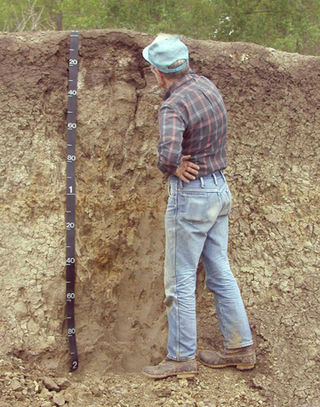
Soil science is the study of soil as a natural resource on the surface of the Earth including soil formation, classification and mapping; physical, chemical, biological, and fertility properties of soils; and these properties in relation to the use and management of soils.
A soil type is a taxonomic unit in soil science. All soils that share a certain set of well-defined properties form a distinctive soil type. Soil type is a technical term of soil classification, the science that deals with the systematic categorization of soils. Every soil of the world belongs to a certain soil type. Soil type is an abstract term. In nature, you will not find soil types. You will find soils that belong to a certain soil type.

Chernozem, also called black soil, is a black-colored soil containing a high percentage of humus and high percentages of phosphorus and ammonia compounds. Chernozem is very fertile soil and can produce high agricultural yields with its high moisture storage capacity.Chernozems are a Reference Soil Group of the World Reference Base for Soil Resources (WRB)
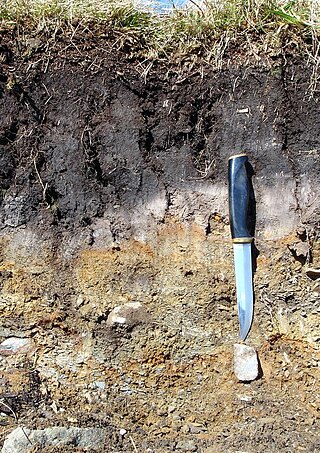
In soil science, podzols are the typical soils of coniferous or boreal forests and also the typical soils of eucalypt forests and heathlands in southern Australia. In Western Europe, podzols develop on heathland, which is often a construct of human interference through grazing and burning. In some British moorlands with podzolic soils, cambisols are preserved under Bronze Age barrows.

Gelisols are an order in USDA soil taxonomy. They are soils of very cold climates which are defined as containing permafrost within two meters of the soil surface. The word "Gelisol" comes from the Latin gelare meaning "to freeze", a reference to the process of cryoturbation that occurs from the alternating thawing and freezing characteristic of Gelisols.
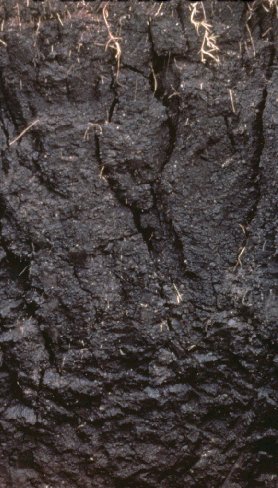
A vertisol is a Soil Order in the USDA soil taxonomy and a Reference Soil Group in the World Reference Base for Soil Resources (WRB). It is also defined in many other soil classification systems. In the Australian Soil Classification it is called vertosol. Vertisols have a high content of expansive clay minerals, many of them belonging to the montmorillonites that form deep cracks in drier seasons or years. In a phenomenon known as argillipedoturbation, alternate shrinking and swelling causes self-ploughing, where the soil material consistently mixes itself, causing some vertisols to have an extremely deep A horizon and no B horizon.. This heaving of the underlying material to the surface often creates a microrelief known as gilgai.

In both the World Reference Base for Soil Resources (WRB) and the USDA soil taxonomy, a Histosol is a soil consisting primarily of organic materials. They are defined as having 40 centimetres (16 in) or more of organic soil material starting within 40 cm from the soil surface. In Soil Taxonomy, Gelisols key out before Histosols, and in WRB, Histosols key out before Cryosols. Therefore, organic permafrost soils belong to the Histosols in WRB and to the Gelisols (Histels) in Soil Taxonomy.
In USDA soil taxonomy, a Psamment is defined as an Entisol which consists basically of unconsolidated sand deposits, often found in shifting sand dunes but also in areas of very coarse-textured parent material subject to millions of years of weathering. This latter case is characteristic of the Guiana Highlands of northern South America. A Psamment has no distinct soil horizons, and must consist entirely of material of loamy sand or coarser in texture. In the World Reference Base for Soil Resources (WRB), most Psamments belong to the Arenosols. However, Psamments of fluviatile, lacustrine or marine origin belong to the Fluvisols.

The World Reference Base for Soil Resources (WRB) is an international soil classification system for naming soils and creating legends for soil maps. The currently valid version is the fourth edition 2022. It is edited by a working group of the International Union of Soil Sciences (IUSS).
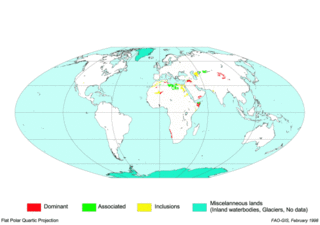
Gypsisols in the World Reference Base for Soil Resources (WRB) are soils with substantial secondary accumulation of gypsum (CaSO4.2H2O). They are found in the driest parts of the arid climate zone. In the USDA soil taxonomy they are classified as Gypsids (USDA Soil Taxonomy), in the Russian soil classification they are called Desert soils (USSR).
An Acrisol is a Reference Soil Group of the World Reference Base for Soil Resources (WRB). It has a clay-rich subsoil and is associated with humid, tropical climates, such as those found in Brazil, and often supports forested areas. In the USDA soil taxonomy, Acrisols correspond to the Humult, Udult and Ustult suborders of the Ultisols and also to Oxisols with a kandic horizon and to some Alfisols. The Acrisols low fertility and toxic amounts of aluminium pose limitations to its agricultural use, favouring in many places its use for silviculture, low intensity pasture and protected areas. Crops that can be successfully cultivated, if climate allows, include tea, rubber tree, oil palm, coffee and sugar cane.
Solonetz is a Reference Soil Group of the World Reference Base for Soil Resources (WRB). They have, within the upper 100 cm of the soil profile, a so-called "natric horizon". There is a subsurface horizon (subsoil), higher in clay content than the upper horizon, that has more than 15% exchangeable sodium. The name is based on the Russian соль. The Ukrainian folk word "solontsi" means salty soil. In Ukraine, many villages are called Solontsі.

A petrocalcic horizon is a diagnostic horizon in the USDA soil taxonomy (ST) and in the World Reference Base for Soil Resources (WRB). They are formed when secondary Calcium Carbonate or other carbonates accumulate in the subsoil to the extent that the soil becomes cemented into a hardpan. Petrocalcic horizons are similar to a duripan and a petrogypsic horizon (WRB) in how they affect land-use limitations. They can occur in conjunction with duripans where the conditions are right and there are enough free carbonates in the soil. Calcium Carbonates are found in alkaline soils, which are typical of arid and semiarid climates. A common field test for the presence of carbonates is application of hydrochloric acid to the soil, which indicates by fizzing and bubbling the presence of calcium carbonates.
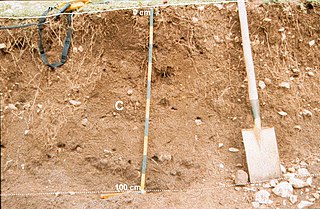
A Regosol in the World Reference Base for Soil Resources (WRB) is very weakly developed mineral soil in unconsolidated materials. Regosols are extensive in eroding lands, in particular in arid and semi-arid areas and in mountain regions. Internationally, Regosols correlate with soil taxa that are marked by incipient soil formation such as Entisols in the USDA soil taxonomy or Rudosols and possibly some Tenosols in the Australian Soil Classification.
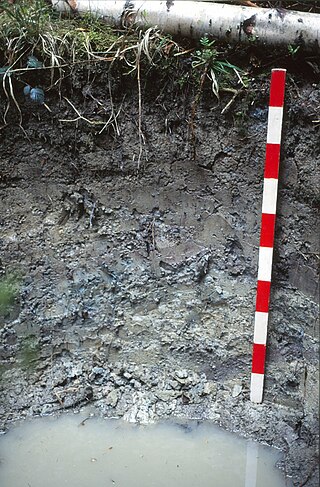
A Stagnosol in the World Reference Base for Soil Resources (WRB) is soil with strong mottling of the soil profile due to redox processes caused by stagnating surface water.
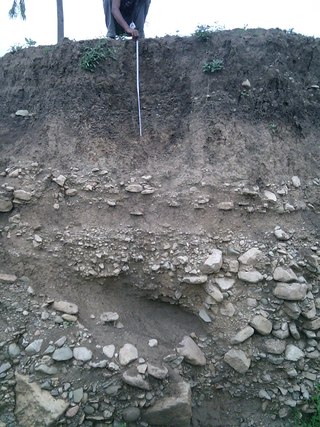
A fluvisol in the World Reference Base for Soil Resources (WRB) is a genetically young soil in alluvial deposits. Apart from river sediments, they also occur in lacustrine and marine deposits. Fluvisols correlate with fluvents and fluvaquents of the USDA soil taxonomy. The good natural fertility of most fluvisols and their attractive dwelling sites on river levees and higher parts in marine landscapes were recognized in prehistoric times.
Kastanozem is one of the 32 Reference Soil Groups of the World Reference Base for Soil Resources (WRB). These soils are brighter than Chernozems, and are related to the Mollisols in the USDA soil taxonomy. They are rich in humus, and originally covered with early maturing native grasslands vegetation, which produces a characteristic brown surface layer in the first meter in depth. They have a relative high level of available calcium ions bound to soil particles and can have a petrocalcic horizon between 25 and 100 cm thick.
Luvisols are a group of soils, comprising one of the 32 Reference Soil Groups in the international system of soil classification, the World Reference Base for Soil Resources (WRB). They are widespread, especially in temperate climates, and are generally fertile. Luvisols are widely used for agriculture.

Nitisol, in the World Reference Base for Soil Resources (WRB), is a deep, red, well-drained soil with a clay content of at least 30% and a polyhedral structure or a blocky structure, breaking into a polyhedral or a flat-edged structure. The soil aggregates show pressure faces. Nitisols correlate with the kandic alfisols, ultisols and inceptisols of the USDA soil taxonomy.

A Phaeozem in the World Reference Base for Soil Resources (WRB) is a dark soil with a high base status, but without a secondary carbonates within one metre of the soil surface. Most Phaeozems correlate with the Udolls (Mollisols) of the USDA soil taxonomy.
{{cite web}}: CS1 maint: multiple names: authors list (link)Technical soil classification systems focus on representing some specific facet or quality of the soil, rather than a direct pedogenetic classification. Such technical classifications are developed with specific applications in mind, such as soil-water relationships, land quality assessment or geotechnical engineering.